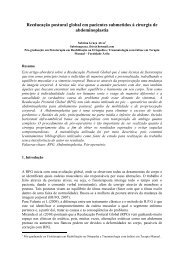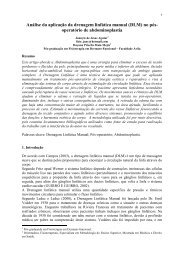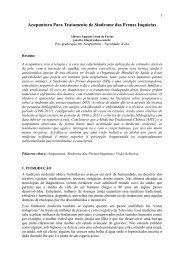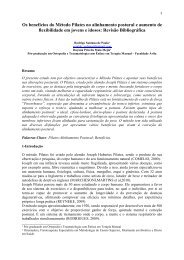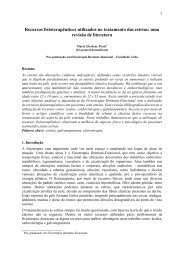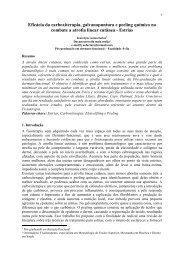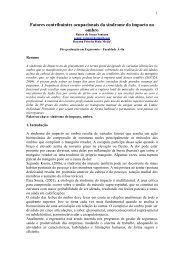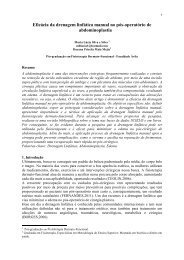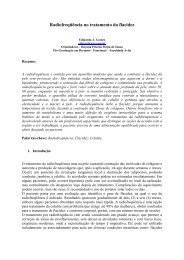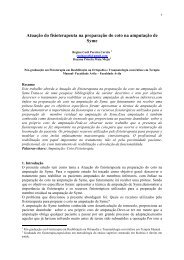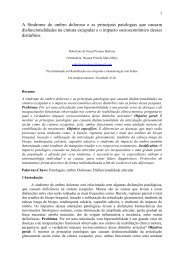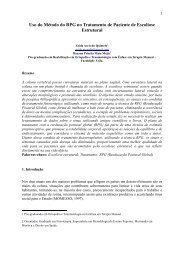Motor learning: its relevance to stroke recovery and ... - Bio Cursos
Motor learning: its relevance to stroke recovery and ... - Bio Cursos
Motor learning: its relevance to stroke recovery and ... - Bio Cursos
You also want an ePaper? Increase the reach of your titles
YUMPU automatically turns print PDFs into web optimized ePapers that Google loves.
<strong>Mo<strong>to</strong>r</strong> <strong>learning</strong>: <strong>its</strong> <strong>relevance</strong> <strong>to</strong> <strong>stroke</strong> <strong>recovery</strong><br />
<strong>and</strong> neurorehabilitation<br />
John W. Krakauer<br />
Purpose of review<br />
Much of neurorehabilitation rests on the assumption that<br />
patients can improve with practice. This review will focus on<br />
arm movements <strong>and</strong> address the following questions:<br />
(i) What is mo<strong>to</strong>r <strong>learning</strong>? (ii) Do patients with hemiparesis<br />
have a <strong>learning</strong> deficit? (iii) Is <strong>recovery</strong> after injury a form of<br />
mo<strong>to</strong>r <strong>learning</strong>? (iv) Are approaches based on mo<strong>to</strong>r<br />
<strong>learning</strong> principles useful for rehabilitation?<br />
Recent findings<br />
<strong>Mo<strong>to</strong>r</strong> <strong>learning</strong> can be broken in<strong>to</strong> kinematic <strong>and</strong> dynamic<br />
components. Studies in healthy subjects suggest that<br />
retention of mo<strong>to</strong>r <strong>learning</strong> is best accomplished with<br />
variable training schedules. Animal models <strong>and</strong> functional<br />
imaging in humans show that the mature brain can undergo<br />
plastic changes during both <strong>learning</strong> <strong>and</strong> <strong>recovery</strong>.<br />
Quantitative mo<strong>to</strong>r control approaches allow differentiation<br />
between compensation <strong>and</strong> true <strong>recovery</strong>, although both<br />
improve with practice. Several promising new rehabilitation<br />
approaches are based on theories of mo<strong>to</strong>r <strong>learning</strong>. These<br />
include impairment oriented-training (IOT), constraintinduced<br />
movement therapy (CIMT), electromyogram<br />
(EMG)-triggered neuromuscular stimulation, robotic<br />
interactive therapy <strong>and</strong> virtual reality (VR).<br />
Summary<br />
<strong>Mo<strong>to</strong>r</strong> <strong>learning</strong> mechanisms are operative during<br />
spontaneous <strong>stroke</strong> <strong>recovery</strong> <strong>and</strong> interact with rehabilitative<br />
training. For optimal results, rehabilitation techniques<br />
should be geared <strong>to</strong>wards patients’ specific mo<strong>to</strong>r defic<strong>its</strong><br />
<strong>and</strong> possibly combined, for example, CIMT with VR. Two<br />
critical questions that should always be asked of a<br />
rehabilitation technique are whether gains persist for a<br />
significant period after training <strong>and</strong> whether they generalize<br />
<strong>to</strong> untrained tasks.<br />
Keywords<br />
hemiparesis, mo<strong>to</strong>r control, mo<strong>to</strong>r <strong>learning</strong>, reaching,<br />
rehabilitation, <strong>stroke</strong> <strong>recovery</strong><br />
Curr Opin Neurol 19:84–90. ß 2006 Lippincott Williams & Wilkins.<br />
Stroke <strong>and</strong> Critical Care Division, Department of Neurology, Columbia University<br />
College of Physicians <strong>and</strong> Surgeons, New York NY, USA<br />
Correspondence <strong>to</strong> John W. Krakauer MD, The Neurological Institute, 710 West<br />
168th Street, New York NY 10032, USA<br />
Tel: +1 212 305 1710; fax: +1 212 305 1658; e-mail: jwk18@columbia.edu<br />
Current Opinion in Neurology 2006, 19:84–90<br />
84<br />
Abbreviations<br />
ADL activities of daily living<br />
CIMT constraint-induced movement therapy<br />
EMG electromyogram<br />
VR virtual reality<br />
ß 2006 Lippincott Williams & Wilkins<br />
1350-7540<br />
Introduction<br />
‘Rehabilitation, for patients, is fundamentally a process of<br />
re<strong>learning</strong> how <strong>to</strong> move <strong>to</strong> carry out their needs successfully’<br />
[1]. This statement succinctly points out the fact<br />
that rehabilitation is predicated on the assumption<br />
that practice or training leads <strong>to</strong> improvement of skills<br />
after hemiparesis. Despite this underlying assumption,<br />
research in mo<strong>to</strong>r control <strong>and</strong> mo<strong>to</strong>r <strong>learning</strong> has only<br />
recently begun <strong>to</strong> make an impact on the practice of<br />
rehabilitation. Instead, <strong>stroke</strong> rehabilitation has focused<br />
either on passive facilitation of isolated movements or<br />
teaching patients <strong>to</strong> function independently using movements<br />
alternative <strong>to</strong> the ones they used before their<br />
<strong>stroke</strong>. In addition, inordinate emphasis has been placed<br />
on therapy for spasticity despite substantial evidence<br />
indicating that it does not make a significant contribution<br />
<strong>to</strong> movement dysfunction [2].<br />
<strong>Mo<strong>to</strong>r</strong> control <strong>and</strong> mo<strong>to</strong>r <strong>learning</strong> in healthy<br />
subjects<br />
<strong>Mo<strong>to</strong>r</strong> <strong>learning</strong> does not need <strong>to</strong> be rigidly defined in<br />
order <strong>to</strong> be effectively studied. Instead it is better<br />
thought of as a fuzzy category [3 ] that includes skill<br />
acquisition, mo<strong>to</strong>r adaptation, such as prism adaptation,<br />
<strong>and</strong> decision making, that is, the ability <strong>to</strong> select the<br />
correct movement in the proper context. A mo<strong>to</strong>r skill is<br />
the ability <strong>to</strong> plan <strong>and</strong> execute a movement goal. The<br />
computational steps required <strong>to</strong> go from goal <strong>to</strong> action for<br />
reaching movements have been extensively studied over<br />
the last 20 years (see the monograph by Shadmehr <strong>and</strong><br />
Wise [3 ]) but the knowledge of mo<strong>to</strong>r control gained<br />
has only recently begun <strong>to</strong> be applied <strong>to</strong> the characterization<br />
<strong>and</strong> treatment of the mo<strong>to</strong>r deficit after hemiparesis.<br />
<strong>Mo<strong>to</strong>r</strong> control scientists make an important distinction<br />
between the geometry <strong>and</strong> speed of a movement<br />
(kinematics) <strong>and</strong> the forces needed <strong>to</strong> generate the movement<br />
(dynamics). This distinction can be better<br />
Copyright © Lippincott Williams & Wilkins. Unauthorized reproduction of this article is prohibited.
unders<strong>to</strong>od by imagining tracing a circle in the air with<br />
your h<strong>and</strong> or with your foot. The circle may have the<br />
same radius <strong>and</strong> be traced at the same speed with the<br />
h<strong>and</strong> <strong>and</strong> the foot, but completely different muscles <strong>and</strong><br />
forces are needed <strong>to</strong> generate the circle in the two cases.<br />
Similarly, reaching trajec<strong>to</strong>ries involving more than one<br />
joint consistently have near-invariant kinematic characteristics:<br />
straight paths <strong>and</strong> bell-shaped velocity profiles<br />
[4], which suggest reaching trajec<strong>to</strong>ries are planned in<br />
advance without initial need <strong>to</strong> take account of limb<br />
dynamics. In the execution phase, mo<strong>to</strong>r comm<strong>and</strong>s take<br />
the complex viscoelastic <strong>and</strong> inertial properties of multijointed<br />
limbs in<strong>to</strong> account so that the appropriate force is<br />
applied <strong>to</strong> generate the desired motion. Thus mo<strong>to</strong>r<br />
control is modular [5], even a simple reaching movement<br />
is made up of separate operations, each of which may<br />
or may not be affected by a lesion. Within this mo<strong>to</strong>r<br />
control framework, skill acquisition can be unders<strong>to</strong>od as<br />
practice-dependent reduction of kinematic <strong>and</strong> dynamic<br />
performance errors detected through visual <strong>and</strong> proprioceptive<br />
sensory channels, respectively [6].<br />
An experimental paradigm that is widely used <strong>to</strong> study<br />
mo<strong>to</strong>r <strong>learning</strong> involves having subjects hold the h<strong>and</strong>le<br />
of a robotic arm <strong>and</strong> make planar reaching movements in<br />
a horizontal plane <strong>to</strong> visual targets displayed on a screen<br />
[7]. <strong>Mo<strong>to</strong>r</strong>s driving the robot arm can be programmed <strong>to</strong><br />
generate specific force-fields that act upon the moving<br />
arm. One type of force-field, called a viscous curl field,<br />
generates forces perpendicular <strong>to</strong> the direction <strong>and</strong> proportional<br />
<strong>to</strong> the velocity of h<strong>and</strong> movement. Before the<br />
mo<strong>to</strong>rs are switched on, subjects are able <strong>to</strong> hold the<br />
h<strong>and</strong>le <strong>and</strong> make reaching movements with smooth <strong>and</strong><br />
straight trajec<strong>to</strong>ries. When first exposed <strong>to</strong> the viscous<br />
curl field, subjects make skewed trajec<strong>to</strong>ries, but with<br />
practice are able <strong>to</strong> adapt <strong>to</strong> the force-field <strong>and</strong> again<br />
make smooth <strong>and</strong> nearly straight movements. When<br />
subjects are in this adapted state <strong>and</strong> the force-field is<br />
turned off, ‘after-effects’ occur, with trajec<strong>to</strong>ries now<br />
skewed in the direction opposite <strong>to</strong> that seen during<br />
initial adaptation. The presence of after-effects is strong<br />
evidence that the central nervous system can alter mo<strong>to</strong>r<br />
comm<strong>and</strong>s <strong>to</strong> the arm <strong>to</strong> predict the effects of the forcefield<br />
<strong>and</strong> form a new mapping between limb state <strong>and</strong><br />
muscle forces (internal model). Experiments indicate<br />
that internal models learned for one type of movement<br />
can generalize <strong>to</strong> other movements [8]. The importance<br />
of the concept of internal model <strong>to</strong> rehabilitation is that<br />
the model can be updated as the state of the limb<br />
changes. Thus rehabilitation needs <strong>to</strong> emphasize techniques<br />
that promote formation of appropriate internal<br />
models <strong>and</strong> not just repetition of movements. As we shall<br />
see below, variations on this robot paradigm have been<br />
used <strong>to</strong> investigate mo<strong>to</strong>r <strong>learning</strong> in patients with<br />
hemiparesis <strong>and</strong> <strong>to</strong> build robotic assistive devices<br />
for rehabilitation.<br />
<strong>Mo<strong>to</strong>r</strong> <strong>learning</strong> <strong>and</strong> <strong>stroke</strong> <strong>recovery</strong> Krakauer 85<br />
Training schedules<br />
The most fundamental principle in mo<strong>to</strong>r <strong>learning</strong> is that<br />
the degree of performance improvement is dependent on<br />
the amount of practice [9]. Practice at <strong>its</strong> simplest is just<br />
performing the same movement repeatedly. Although<br />
this may be the most effective way <strong>to</strong> improve performance<br />
during the training session <strong>its</strong>elf, it is not optimal for<br />
retaining <strong>learning</strong> over time. As Winstein et al. state ‘All<br />
<strong>to</strong>o often we forget about the seductive <strong>and</strong> often misleading<br />
temporary changes in performance <strong>and</strong> take them<br />
<strong>to</strong> reflect <strong>learning</strong> when in fact, little persistence of that<br />
change is evident even after a short interval’ [10]. It has<br />
been known for some time that practice can be accomplished<br />
in a number of ways that are more effective than<br />
blocked repetition of a single task (massed practice).<br />
A consistent finding in the literature is that introducing<br />
frequent <strong>and</strong> longer rest periods between repetitions<br />
(distributed practice) improves performance <strong>and</strong> <strong>learning</strong>.<br />
The second finding is that introducing task variability in<br />
the acquisition session improves performance in a subsequent<br />
session (retention) even though performance<br />
during acquisition may be worse than if the task were<br />
constant [11]. A hypothetical example is reaching <strong>to</strong> pick<br />
up a glass on a table. The therapist can either have the<br />
patient reach <strong>and</strong> grasp the same glass at a fixed distance<br />
repeatedly or have the patient pick up the glass at varying<br />
speeds <strong>and</strong> distances. Although the patient may reach for<br />
the glass better during the constant session, the patient<br />
reaches for the glass better at retention after the variable<br />
session. Another benefit of variable practice is that it<br />
increases generalization of <strong>learning</strong> <strong>to</strong> new tasks. The idea<br />
of generalization is of critical importance <strong>to</strong> rehabilitation.<br />
Training subjects on a task repeatedly in the clinic<br />
may lead <strong>to</strong> improved performance in that particular task<br />
but not transfer <strong>to</strong> any activities of daily living (ADL)<br />
when they get back home.<br />
Another robust finding is that of contextual interference:<br />
r<strong>and</strong>om ordering of n trials of x tasks leads <strong>to</strong> better<br />
performance of each of the tasks after a retention interval<br />
than if a single task were practiced alone [12]. So in the<br />
reaching example, the patient might reach r<strong>and</strong>omly for a<br />
glass, then a spoon, then a telephone. There is a need <strong>to</strong><br />
test efficacy of rehabilitation through tests of recall <strong>and</strong><br />
transfer rather than performance at the time of training.<br />
In addition, the effects of practice schedule need <strong>to</strong> be<br />
applied <strong>to</strong> research on rehabilitation techniques <strong>and</strong><br />
mo<strong>to</strong>r <strong>recovery</strong> after <strong>stroke</strong>. An example of such a study<br />
compared practice under conditions of contextual interference<br />
(r<strong>and</strong>om practice) <strong>and</strong> massed practice in patients<br />
with chronic hemiparesis. The patients who learned with<br />
r<strong>and</strong>om practice showed superior retention of the trained<br />
functional movement sequence [13]. The reason why a<br />
r<strong>and</strong>om schedule might aid <strong>recovery</strong> is that it promotes<br />
considering each movement as a problem <strong>to</strong> be solved,<br />
rather than a time of sequence of muscle forces <strong>to</strong> be<br />
Copyright © Lippincott Williams & Wilkins. Unauthorized reproduction of this article is prohibited.
86 Cerebrovascular disease<br />
memorized <strong>and</strong> then replayed. It is the goal not the<br />
movement that has <strong>to</strong> be repeated. When we reach for<br />
a glass of water we do so differently each time because of<br />
small differences in posture, position of the glass relative<br />
<strong>to</strong> the body etc. Nevertheless, a reach is always successfully<br />
achieved. Within the context of the practice<br />
schedule, it may be that the influential idea of a mo<strong>to</strong>r<br />
<strong>recovery</strong> plateau at 6 months after <strong>stroke</strong> reflects asymp<strong>to</strong>tic<br />
<strong>learning</strong> after massed practice rather than a true<br />
biological limit [14 ].<br />
<strong>Mo<strong>to</strong>r</strong> <strong>learning</strong> in patients with hemiparesis<br />
There have been surprisingly few studies of mo<strong>to</strong>r <strong>learning</strong><br />
after <strong>stroke</strong> <strong>and</strong> almost none looking at defic<strong>its</strong><br />
in mo<strong>to</strong>r memory formation despite the likely <strong>relevance</strong><br />
of these processes <strong>to</strong> rehabilitation [15] <strong>and</strong> <strong>recovery</strong> [16].<br />
Winstein <strong>and</strong> colleagues [17] tested the ipsilesional<br />
arm in patients with middle cerebral artery terri<strong>to</strong>ry<br />
infarctions using an extension-flexion elbow reversal<br />
task on a horizontal surface with feedback given as<br />
knowledge-of-results. The authors found no difference<br />
in acquisition on day 1 or recall on day 2 between<br />
patients <strong>and</strong> controls although patients were less accurate<br />
overall. Only the ipsilesional arm was tested, however,<br />
so a <strong>learning</strong> deficit in the affected arm was not<br />
evaluated. A more recent study [18] showed impaired<br />
adaptation of the paretic arm <strong>to</strong> a laterally displacing<br />
force-field generated by a robot arm. Patients showed<br />
reduced capacity <strong>to</strong> make straight movements in the<br />
force-field <strong>and</strong> showed reduced after-effects. The authors<br />
concluded, however, that patients did not have a <strong>learning</strong><br />
deficit per se but weakness-related slowness <strong>to</strong><br />
develop the required force <strong>to</strong> implement anticipa<strong>to</strong>ry<br />
control. Thus, at the current time it remains uncertain<br />
whether there are specific mo<strong>to</strong>r <strong>learning</strong> defic<strong>its</strong> in<br />
patients with hemiparesis. There are a number of reasons<br />
for this. First, there have been <strong>to</strong>o few studies. Second,<br />
there are many types of mo<strong>to</strong>r <strong>learning</strong> <strong>and</strong> they may be<br />
differentially affected depending on lesion location.<br />
Third, it can be difficult <strong>to</strong> demonstrate a <strong>learning</strong><br />
abnormality in patients when performance is already<br />
considerably impaired at baseline.<br />
Is <strong>recovery</strong> from hemiparesis a form of<br />
mo<strong>to</strong>r <strong>learning</strong>?<br />
Longitudinal studies suggest that <strong>recovery</strong> from<br />
hemiparesis proceeds through a series of fairly stereotypical<br />
stages over the first 6 months post-<strong>stroke</strong>, irrespective<br />
of the kind of therapeutic intervention [19].<br />
In particular, although there is heterogeneity in <strong>stroke</strong><br />
severity <strong>and</strong> <strong>recovery</strong> across individuals, it has been<br />
shown that the time course of the change in the Barthel<br />
Index for patients with middle cerebral artery <strong>stroke</strong><br />
is well fitted by a logistic regression model [20]. The<br />
model indicates that the earlier that patients show <strong>recovery</strong>,<br />
the better the outcome at 6 months <strong>and</strong> that<br />
the Barthel Index at 1 week explains about 56% of the<br />
variance in outcome at 6 months. A similar logistic<br />
regression was used <strong>to</strong> predict the likelihood of <strong>recovery</strong><br />
of h<strong>and</strong> dexterity at 6 months, assessed using the action<br />
research arm test, in patients presenting with flaccid<br />
hemiplegia [20]. It was found that if patients failed <strong>to</strong><br />
reach an arm Fugl-Meyer score of 11 or more by week 4<br />
then they had only a 6% chance of regaining dexterity at 6<br />
months. Notably, this probability did not change over the<br />
ensuing 5 months. Thus, there is a process of spontaneous<br />
<strong>recovery</strong> that is maximally expressed in the first 4 weeks<br />
post-<strong>stroke</strong> <strong>and</strong> then tapers off over 6 months. Several<br />
mechanisms are likely for this spontaneous <strong>recovery</strong>,<br />
including restitution of the ischemic penumbra, resolution<br />
of diaschisis, <strong>and</strong> brain reorganization. Although<br />
some aspects of brain reorganization are probably unique<br />
<strong>to</strong> brain injury, there are large overlaps with development<br />
[21,22] <strong>and</strong> mo<strong>to</strong>r <strong>learning</strong> [23,24]. A recent study in a rat<br />
<strong>stroke</strong> model demonstrates the critical interaction<br />
between rehabilitation <strong>and</strong> spontaneous <strong>recovery</strong> processes<br />
early after <strong>stroke</strong> [25]. Rehabilitation initiated 5<br />
days after focal ischemia was much more effective than<br />
waiting for 1 month before beginning rehabilitation. This<br />
difference correlated with the degree of increased dendritic<br />
complexity <strong>and</strong> arborization in undamaged mo<strong>to</strong>r<br />
cortex. A similar time-window effect, albeit longer than in<br />
rats, has been shown in patients after <strong>stroke</strong>, with the<br />
greatest gains from rehabilitation occurring in the first 6<br />
months [26].<br />
Improvement with rehabilitation increases with the<br />
amount of training <strong>and</strong> relates mostly <strong>to</strong> the task practised<br />
during therapy, with little generalization <strong>to</strong> other mo<strong>to</strong>r<br />
tasks. Thus, <strong>recovery</strong> related <strong>to</strong> spontaneous biological<br />
processes seems <strong>to</strong> improve performance across a range of<br />
tasks whereas <strong>recovery</strong> mediated by training, like <strong>learning</strong><br />
in healthy subjects, is more task-specific. This difference<br />
raises the important issue of true <strong>recovery</strong> versus<br />
compensation <strong>and</strong> how they both relate <strong>to</strong> mo<strong>to</strong>r <strong>learning</strong>.<br />
True <strong>recovery</strong> means that undamaged brain regions are<br />
recruited, which generate comm<strong>and</strong>s <strong>to</strong> the same muscles<br />
as were used before the injury. This implies some<br />
redundancy in mo<strong>to</strong>r cortical areas with unmasking,<br />
through training, of pre-existing corticocortical connections<br />
[27]. Compensation, in contrast, is the use of<br />
alternative muscles <strong>to</strong> accomplish the task goal. For<br />
example, a patient with right arm plegia can compensate<br />
by using their left arm. Nevertheless, despite the clear<br />
distinction, <strong>learning</strong> is required for both true <strong>recovery</strong> <strong>and</strong><br />
compensation. Experiments in monkeys clearly demonstrate<br />
the importance of <strong>learning</strong> for <strong>recovery</strong> of function<br />
[28,29]. A sub<strong>to</strong>tal lesion confined <strong>to</strong> a small portion of<br />
the representation of one h<strong>and</strong> resulted in further loss of<br />
h<strong>and</strong> terri<strong>to</strong>ry in the adjacent, undamaged cortex of adult<br />
squirrel monkeys if the h<strong>and</strong> was not used. Subsequent<br />
reaching relied on compensa<strong>to</strong>ry proximal movements of<br />
Copyright © Lippincott Williams & Wilkins. Unauthorized reproduction of this article is prohibited.
the elbow <strong>and</strong> shoulder. Forced retraining of skilled h<strong>and</strong><br />
use, however, prevented loss of h<strong>and</strong> terri<strong>to</strong>ry adjacent <strong>to</strong><br />
the infarct. In some instances, the h<strong>and</strong> representations<br />
exp<strong>and</strong>ed in<strong>to</strong> regions formerly occupied by representations<br />
of the elbow <strong>and</strong> shoulder. This functional<br />
reorganization in the undamaged mo<strong>to</strong>r cortex was<br />
accompanied by behavioral <strong>recovery</strong> of skilled h<strong>and</strong> function.<br />
These results suggest that, after local damage <strong>to</strong> the<br />
mo<strong>to</strong>r cortex, rehabilitative training can shape subsequent<br />
<strong>recovery</strong>-related reorganization in the adjacent<br />
intact cortex. Critically, cortical changes may only occur<br />
with <strong>learning</strong> of new skills <strong>and</strong> not just with repetitive use<br />
[24]. It is unclear at this time whether simple repetition of<br />
a task that was previously well-learned is sufficient <strong>to</strong><br />
induce significant cortical reorganization or whether<br />
patient should be challenged on more difficult tasks.<br />
The answer may depend on the amount of salient error<br />
information provided (see section below on virtual<br />
reality).<br />
The ability <strong>to</strong> compensate for a deficit is also dependent<br />
on mo<strong>to</strong>r <strong>learning</strong>, as any right-h<strong>and</strong>er who has tried <strong>to</strong><br />
write with their left h<strong>and</strong> quickly realizes. Thus <strong>to</strong> the<br />
degree that all rehabilitation is a form of mo<strong>to</strong>r <strong>learning</strong>, it<br />
can occur <strong>to</strong> promote both true <strong>recovery</strong> <strong>and</strong> compensation.<br />
A recent study of focal cortical ischemia in adult<br />
rats suggests that mo<strong>to</strong>r improvement is mediated principally<br />
by compensa<strong>to</strong>ry mechanisms rather than true<br />
<strong>recovery</strong>. Indeed, some animals developed a compensa<strong>to</strong>ry<br />
movement strategy that was more successful than the<br />
one used prior <strong>to</strong> the lesion [30 ]. Most interestingly, the<br />
rate of improvement with training was similar before <strong>and</strong><br />
after the lesion, suggesting that a similar <strong>learning</strong> mechanism<br />
was operative with <strong>and</strong> without injury. Another<br />
recent study of focal ischemic brain injury in rats suggests<br />
that the undamaged (ipsilateral) hemisphere may be the<br />
ana<strong>to</strong>mical substrate for compensa<strong>to</strong>ry improvement<br />
[31]. These animal studies indicate the benef<strong>its</strong> of<br />
detailed behavioral analysis. Unfortunately, outcome<br />
scales commonly used in clinical rehabilitation trials do<br />
not have the resolution <strong>to</strong> distinguish between compensation<br />
<strong>and</strong> true <strong>recovery</strong>. This is a serious limitation for a<br />
number of reasons. First, it has been stated that the<br />
failure of many recent clinical <strong>stroke</strong> trials may relate<br />
more <strong>to</strong> the choice of outcome measures rather than<br />
<strong>to</strong> the lack of efficacy of the agent under investigation<br />
[32]. Second, inappropriate compensa<strong>to</strong>ry strategies<br />
may limit <strong>recovery</strong> after <strong>stroke</strong> [33]. Third, in order <strong>to</strong><br />
underst<strong>and</strong> brain changes that occur in response <strong>to</strong><br />
therapy it is imperative that brain changes due <strong>to</strong><br />
compensation are not misinterpreted as evidence for<br />
reorganization. The application of quantitative movement<br />
analysis <strong>and</strong> the mo<strong>to</strong>r control framework described<br />
in the previous sections should overcome these<br />
limitations <strong>and</strong> allow accurate assessment of the efficacy<br />
of rehabilitation techniques.<br />
<strong>Mo<strong>to</strong>r</strong> <strong>learning</strong> <strong>and</strong> <strong>stroke</strong> <strong>recovery</strong> Krakauer 87<br />
Rehabilitation methods based on mo<strong>to</strong>r<br />
<strong>learning</strong><br />
This section will review five rehabilitation techniques<br />
based on mo<strong>to</strong>r <strong>learning</strong> principles. Some target patients<br />
with a particular degree of hemiparesis while others are<br />
appropriate across the spectrum from mild hemiparesis <strong>to</strong><br />
hemiplegia. It can be envisaged that patients could be<br />
tried on the techniques in combination or graduate from<br />
one <strong>to</strong> another as they improve.<br />
Arm ability training: impairment-oriented training for<br />
mild hemiparesis<br />
This technique was developed for patients with mild<br />
hemiparesis [34], who complain of clumsiness <strong>and</strong><br />
decreased coordination even though they may have<br />
normal neurological examinations <strong>and</strong> arm Fugl-Meyer<br />
scores. Defic<strong>its</strong> may only be apparent with more sensitive<br />
kinematic testing [35]. These patients, however, are the<br />
most likely <strong>to</strong> return <strong>to</strong> work after their <strong>stroke</strong> <strong>and</strong> so their<br />
defic<strong>its</strong>, albeit mild, can be devastating, for example, for<br />
electricians, hairdressers, or musicians. The arm ability<br />
training tasks were chosen based on a fac<strong>to</strong>rial analysis of<br />
different abilities in healthy subjects: h<strong>and</strong> grip, finger<br />
individuation, arm-h<strong>and</strong> steadiness, aimed reaching,<br />
tracking, <strong>and</strong> wrist-finger speed. The pro<strong>to</strong>col incorporates<br />
many of the concepts from the mo<strong>to</strong>r <strong>learning</strong><br />
literature in order <strong>to</strong> maximize retention <strong>and</strong> generalization<br />
of what is learned during the rehabilitation session.<br />
For example, although tasks are practiced repetitively,<br />
variability is introduced by varying the difficulty of each<br />
of the tasks. A r<strong>and</strong>omized clinical trial showed a benefit<br />
of arm ability training compared with st<strong>and</strong>ard rehabilitation,<br />
as assessed by a measure of efficiency of arm function<br />
in ADLs [34]. The emphasis of the arm ability<br />
training pro<strong>to</strong>col focuses on impairment rather than on<br />
disability or quality of life measures is more congruent<br />
with neuroscientific findings, which indicate that mo<strong>to</strong>r<br />
control <strong>and</strong> mo<strong>to</strong>r <strong>learning</strong> are modular [5].<br />
Constraint-induced movement therapy (CIMT)<br />
This technique has garnered a large amount of attention<br />
because it has shown that even patients with chronic<br />
<strong>stroke</strong> (> 6 months out) can show meaningful gains (for a<br />
recent review, see [36]). The technique has two components<br />
<strong>and</strong> is usually given over 2 weeks: (i) restraint<br />
of the less-affected extremity for 90% of waking hours;<br />
(ii) massed practice with the affected limb for 6 hours a<br />
day using shaping. In patients with chronic hemiparesis,<br />
the restraint is conjectured <strong>to</strong> help patients overcome<br />
learned non-use, whereas in patients with acute <strong>stroke</strong> it<br />
can be seen as a way <strong>to</strong> prevent adoption of compensa<strong>to</strong>ry<br />
strategies with the unaffected limb. Shaping is a form of<br />
operant conditioning whereby performance is consistently<br />
rewarded – essentially the reverse of the mechanism<br />
by which patients are posited <strong>to</strong> learn non-use.<br />
Learned non-use is based on the idea that the affected<br />
Copyright © Lippincott Williams & Wilkins. Unauthorized reproduction of this article is prohibited.
88 Cerebrovascular disease<br />
limb has potential ability that is unrealized because of<br />
excessive reliance on the unaffected limb. To be eligible<br />
for CIMT, patients must have at least 108 of wrist <strong>and</strong><br />
finger extension. Several studies have now been published<br />
showing a significant benefit for CIMT in patients<br />
with chronic hemiparesis [37–39].<br />
CIMT, however, remains controversial [40,41] <strong>and</strong> a number<br />
of issues still need <strong>to</strong> be resolved. First, the restraint is<br />
frustrating <strong>and</strong> there is preliminary data showing that<br />
massed practice alone can yield a significant benefit<br />
[42]. Second, the greatest benefit is seen when outcome<br />
is measured by the mo<strong>to</strong>r activity log. This is an ordinal<br />
scale from 0–5, which requires patients <strong>to</strong> assess their<br />
performance on mo<strong>to</strong>r ADLs, both in terms of how much<br />
they use the affected arm compared with the unaffected<br />
arm <strong>and</strong> on the quality of their movements. Less benefit is<br />
seen when impairment is measured. This discrepancy has<br />
been explained by Taub <strong>and</strong> colleagues as evidence for<br />
learned non-use: the patients who benefit the most are<br />
those who can move the limb well but do not out of habit<br />
[36]. This is unconvincing because it suggests that the<br />
restraint alone should have a large effect when most<br />
investiga<strong>to</strong>rs believe that it is the intense daily therapy<br />
that accounts for the largest part of the effect of CIMT.<br />
Third, <strong>to</strong> be eligible for CIMT, patients must have at least<br />
108 of wrist <strong>and</strong> finger extension, thereby excluding many<br />
patients. Fourth, it has recently been reported that intense<br />
rehabilitation (not CIMT) in the acute phase after <strong>stroke</strong><br />
has little impact on ADLs 4 years post-<strong>stroke</strong>. Thus, it<br />
would be surprising if 2 weeks of treatment could have<br />
long-lasting effects either when administered in the acute<br />
or chronic setting. So far, patients have been followed out<br />
for 2 years with evidence for persistent benefit <strong>and</strong> those<br />
with greater impairment have a 20% reduction in mo<strong>to</strong>r<br />
activity log after 1 year [37].<br />
Overall, despite the large amount of interest in CIMT, it<br />
still remains unclear what of type of <strong>recovery</strong> is actually<br />
occurring. A form of CIMT occurs when healthy subjects<br />
practice h<strong>and</strong>writing with their non-dominant h<strong>and</strong>. The<br />
improvement has been analyzed kinematically <strong>and</strong> it<br />
appears <strong>to</strong> occur at the level of individual <strong>stroke</strong>s with<br />
true increase in skill, with decreased <strong>stroke</strong> duration <strong>and</strong><br />
increased velocity without degradation in accuracy [43]. A<br />
similar detailed analysis needs <strong>to</strong> be done in patients <strong>to</strong> see<br />
if CIMT leads <strong>to</strong> a true increase in skill <strong>and</strong> whether this<br />
increase in skill is through use of a compensa<strong>to</strong>ry mechanism<br />
or true <strong>recovery</strong>. In addition, given what we have<br />
discussed about training schedules, it would be desirable <strong>to</strong><br />
move away from massed practice over 2 weeks <strong>and</strong> see if<br />
more variable conditions of practice could be employed.<br />
Electromyogram-triggered neuromuscular stimulation<br />
Electromyogram (EMG)-triggered neuromuscular stimulation<br />
is based on sensorimo<strong>to</strong>r integration theory, which<br />
pos<strong>its</strong> that non-damaged mo<strong>to</strong>r areas can be recruited <strong>and</strong><br />
trained <strong>to</strong> plan more effective movements using timelocked<br />
movement-related afference [44]. The critical<br />
importance of sensory input <strong>to</strong> mo<strong>to</strong>r <strong>learning</strong> was<br />
demonstrated in an experiment in monkeys, in which<br />
the primary sensory h<strong>and</strong> area, known <strong>to</strong> have dense<br />
connections with M1, was ablated [45]. The monkeys<br />
were able <strong>to</strong> execute previously learned tasks normally<br />
but were unable <strong>to</strong> learn new skills. Within this framework,<br />
<strong>recovery</strong> of function is analogous <strong>to</strong> acquiring a new<br />
skill. EMG-triggered neuromuscular stimulation involves<br />
initiating a voluntary contraction for a specific movement<br />
until the muscle activity reaches a threshold level. When<br />
EMG activity reaches the chosen threshold, an assistive<br />
electrical stimulus is triggered. A microprocessor connected<br />
<strong>to</strong> surface electrodes moni<strong>to</strong>rs the EMG activity<br />
<strong>and</strong> administers the neuromuscular stimulation. In this<br />
way, two mo<strong>to</strong>r <strong>learning</strong> principles can be coupled in one<br />
pro<strong>to</strong>col: repetition <strong>and</strong> sensorimo<strong>to</strong>r integration. A<br />
typical pro<strong>to</strong>col is <strong>to</strong> have patients make 30 successful<br />
movement trials, for example, full range of wrist extension,<br />
3 days a week for 2 consecutive weeks. A recent<br />
meta-analysis of EMG-triggered neuromuscular stimulation<br />
reveals that it is an effective post-<strong>stroke</strong> treatment<br />
in the acute, subacute <strong>and</strong> chronic phases of <strong>recovery</strong><br />
[46]. Importantly, it has been shown that simple suprathreshold<br />
sensory stimulation, unrelated <strong>to</strong> movement, is<br />
of limited functional value [47]. EMG-triggered neuromuscular<br />
stimulation has also been coupled with two<br />
other behavioral interventions, each based on mo<strong>to</strong>r<br />
<strong>learning</strong> principles. The first of these was a r<strong>and</strong>omized<br />
practice schedule testing the hypothesis that contextual<br />
interference will aid <strong>recovery</strong> [48]. The second was<br />
bilateral coordination training (i.e. mirror movements<br />
with the unaffected arm) [49]. These two studies are<br />
important because they applied findings from the mo<strong>to</strong>r<br />
<strong>learning</strong> literature <strong>to</strong> the design of rehabilitation pro<strong>to</strong>cols<br />
<strong>and</strong> because they show the benef<strong>its</strong> of combining two<br />
techniques simultaneously. It can be envisaged that<br />
patients with limited wrist <strong>and</strong> finger extension could<br />
be treated with EMG-triggered neuromuscular stimulation<br />
first in order <strong>to</strong> meet criteria for subsequent CIMT.<br />
Interactive robotic therapy<br />
The use of robot-induced force-fields <strong>to</strong> study adaptation<br />
<strong>to</strong> dynamic perturbations <strong>and</strong> growing awareness that<br />
mo<strong>to</strong>r <strong>learning</strong> <strong>and</strong> mo<strong>to</strong>r <strong>recovery</strong> share overlapping<br />
neural substrates, led <strong>to</strong> the idea that robotic devices<br />
could be developed <strong>to</strong> provide rehabilitation. Indeed,<br />
robot-assisted rehabilitation is an excellent example of<br />
how concepts from recent research in mo<strong>to</strong>r control can<br />
generate fresh thinking with regard <strong>to</strong> rehabilitation. The<br />
first robot rehabilitation trial used the robot <strong>to</strong> assist<br />
patients with an impedance controller when they made<br />
self-initiated planar reaching <strong>and</strong> drawing movements<br />
[50]. Assistive-therapy is congruent with the sensorimo<strong>to</strong>r<br />
Copyright © Lippincott Williams & Wilkins. Unauthorized reproduction of this article is prohibited.
integration theory that underlies EMG-triggered neuromuscular<br />
stimulation. The patients initiate a movement<br />
<strong>and</strong> are then assisted <strong>to</strong> complete it <strong>and</strong> therefore receive<br />
reafference that can be related <strong>to</strong> the comm<strong>and</strong> <strong>and</strong><br />
the movement. An advantage of the robot over EMGtriggered<br />
neurostimulation is that muscles across more<br />
than one joint can be assisted simultaneously. Subsequent<br />
trials have confirmed benef<strong>its</strong> in acute <strong>and</strong><br />
chronic patients [51,52]. A study that compared robotassisted<br />
therapy with intensive conventional therapy<br />
showed a significantly greater benefit of the robot on<br />
both measures of impairment <strong>and</strong> ADLs [53].<br />
Robots can also be used <strong>to</strong> have patients adapt <strong>to</strong> novel<br />
force-fields, as has been done in healthy subjects. As<br />
discussed above, one study has suggested that patients<br />
with hemiparesis do not learn or implement new internal<br />
models as well as controls. Nevertheless, a force-field<br />
environment generated by the robot could challenge<br />
patients <strong>to</strong> learn an internal model in a varying environment.<br />
As we have already seen, a variable training schedule<br />
is better than a massed schedule as it promotes<br />
retention <strong>and</strong> generalization. One interesting approach<br />
has been <strong>to</strong> have patients adapt <strong>to</strong> a force-field that causes<br />
them <strong>to</strong> make directional errors that are even larger than<br />
usual [54]. In the adapted state, the patients revert <strong>to</strong><br />
making their baseline directional errors. When the forcefield<br />
is switched off, however, their after-effects reduce<br />
their baseline directional error. Whether this leads <strong>to</strong><br />
lasting <strong>and</strong> generalizable gains or is just a form of trick<br />
remains <strong>to</strong> be seen. A final great advantage of the robot is<br />
that it provides a way <strong>to</strong> control <strong>and</strong> measure therapeutic<br />
efficacy of both robotic therapy <strong>and</strong> other rehabilitation<br />
techniques. Precise kinematic measurements can be<br />
obtained <strong>and</strong>, if patients are adequately constrained so<br />
that they cannot make compensa<strong>to</strong>ry trunk movements,<br />
it can be ascertained if true <strong>recovery</strong>, defined by the<br />
ability <strong>to</strong> make straight <strong>and</strong> smooth movements, can<br />
actually result from rehabilitation.<br />
Virtual reality-based rehabilitation<br />
Virtual reality (VR) is a simulation of the real world<br />
using a human–machine interface [55 ,56 ]. The equipment<br />
consists of a visual display, head-mounted or on a<br />
moni<strong>to</strong>r; a motion tracking <strong>and</strong>/or force detection device;<br />
<strong>and</strong> augmented sensory feedback. Augmented feedback<br />
means that the feedback is more salient <strong>and</strong> selective<br />
than in the real world. For example, patients can have a<br />
virtual teacher in which properly executed arm movements<br />
are displayed in real-time along with the patient’s<br />
own movements <strong>and</strong> the closeness of the fit between<br />
them given as a score [57]. Similarly, subjects can wear a<br />
cyberglove, which allows them <strong>to</strong> see a two-dimensional<br />
reconstruction of their h<strong>and</strong> with feedback about a<br />
particular aspect of <strong>its</strong> movement emphasized, such as<br />
the range of motion [58].<br />
<strong>Mo<strong>to</strong>r</strong> <strong>learning</strong> <strong>and</strong> <strong>stroke</strong> <strong>recovery</strong> Krakauer 89<br />
The VR set-up can be more or less immersive but<br />
completely immersive VR, in which the environment<br />
appears real <strong>and</strong> three-dimensional, can induce cybersickness.<br />
The main idea behind VR is attractive <strong>and</strong><br />
plausible, namely that it can provide a varied <strong>and</strong> enjoyable<br />
environment in which patients can sustain the<br />
motivation <strong>to</strong> practice for extended periods of time<br />
<strong>and</strong> attend <strong>to</strong> specific components of error feedback.<br />
In essence, the patients are playing a videogame that<br />
rewards <strong>recovery</strong> with points. Nevertheless, the critical<br />
questions that need <strong>to</strong> be answered before investing in<br />
expensive equipment concern whether mo<strong>to</strong>r <strong>learning</strong> in<br />
a virtual environment generalizes <strong>to</strong> the real world <strong>and</strong><br />
whether there are advantages of practice in a virtual<br />
versus a real environment. There is affirmative evidence<br />
for both questions in patients with chronic <strong>stroke</strong>, trained<br />
on VR tasks for the h<strong>and</strong> [57] <strong>and</strong> arm [58]. Although<br />
these studies are small <strong>and</strong> have not included controls,<br />
they highlight the potential of an approach that emphasizes<br />
principles of mo<strong>to</strong>r <strong>learning</strong> <strong>and</strong> then amplifies them<br />
in the VR environment.<br />
References <strong>and</strong> recommended reading<br />
Papers of particular interest, published within the annual period of review, have<br />
been highlighted as:<br />
of special interest<br />
of outst<strong>and</strong>ing interest<br />
Additional references related <strong>to</strong> this <strong>to</strong>pic can also be found in the Current<br />
World Literature section in this issue (pp. 112–113).<br />
1 Carr JH, Shepherd RB, edi<strong>to</strong>rs. Movement Science: Foundations for Physical<br />
Therapy in Rehabilitation. Rockville, MD: Aspen; 1987.<br />
2 O’Dwyer NJ, Ada L, Neilson PD. Spasticity <strong>and</strong> muscle contracture following<br />
<strong>stroke</strong>. Brain 1996; 119:1737–1749.<br />
3 Shadmehr R, Wise SP. The computational neurobiology of reaching <strong>and</strong><br />
pointing: a foundation for mo<strong>to</strong>r <strong>learning</strong>. Cambridge, MA: The MIT Press;<br />
2005.<br />
This is an outst<strong>and</strong>ing detailed overview of the behavioral, physiological <strong>and</strong><br />
computational foundations of mo<strong>to</strong>r <strong>learning</strong>. This book is strongly recommended<br />
<strong>to</strong> anyone who wishes <strong>to</strong> possess a more rigorous foundation for their work on<br />
rehabilitation.<br />
4 Morasso P. Spatial control of arm movements. Exp. Brain Res 1981; 42:223–<br />
227.<br />
5 Mussa-Ivaldi FA. Modular features of mo<strong>to</strong>r control <strong>and</strong> <strong>learning</strong>. Curr Opin<br />
Neurobiol 1999; 9:713–717.<br />
6 Krakauer JW, Ghilardi MF, Ghez C. Independent <strong>learning</strong> of internal models<br />
for kinematic <strong>and</strong> dynamic control of reaching. Nat Neurosci 1999; 2:1026–<br />
1031.<br />
7 Shadmehr R, Mussa-Ivaldi FA. Adaptive representation of dynamics during<br />
<strong>learning</strong> of a mo<strong>to</strong>r task. J Neurosci 1994; 14 (5 Pt 2):3208–3224.<br />
8 Conditt MA, G<strong>and</strong>olfo F, Mussa-Ivaldi FA. The mo<strong>to</strong>r system does not learn<br />
the dynamics of the arm by rote memorization of past experience. J Neurophysiol<br />
1997 Jul; 78:554–560.<br />
9 Schmidt RA, Lee TD. <strong>Mo<strong>to</strong>r</strong> control <strong>and</strong> <strong>learning</strong>. 3rd ed. Champaign, IL:<br />
Human Kinetics Publishers; 1999.<br />
10 Winstein C, Wing AM, Whitall J. <strong>Mo<strong>to</strong>r</strong> control <strong>and</strong> <strong>learning</strong> principles for<br />
rehabilitation of upper limb movements after brain injury. In: Grafman J,<br />
Robertson IH, edi<strong>to</strong>rs. H<strong>and</strong>book of neuropsychology, 2nd ed 2003.<br />
11 Shea CH, Kohl RM. Composition of practice: Influence on the retention of<br />
mo<strong>to</strong>r skills. Res Q Exerc Sport 1991; 62:187–195.<br />
12 Shea JB, Morgan JB. Contextual interference effects on the acquisition,<br />
retention, <strong>and</strong> transfer of a mo<strong>to</strong>r skill. J Exp Psychol: Hum Learn Mem<br />
1979; 5:179–187.<br />
13 Hanlon RE. <strong>Mo<strong>to</strong>r</strong> <strong>learning</strong> following unilateral <strong>stroke</strong>. Arch Phys Med Rehabil<br />
1996; 77:811–815.<br />
Copyright © Lippincott Williams & Wilkins. Unauthorized reproduction of this article is prohibited.
90 Cerebrovascular disease<br />
14 Page SJ, Gater DR, Bach YRP. Reconsidering the mo<strong>to</strong>r <strong>recovery</strong> plateau in<br />
<strong>stroke</strong> rehabilitation. Arch Phys Med Rehabil 2004; 85:1377–1381.<br />
This is a provocative <strong>and</strong> well argued commentary exhorting practitioners <strong>to</strong><br />
reconsider the idea of the mo<strong>to</strong>r <strong>recovery</strong> plateau after <strong>stroke</strong>. The authors point<br />
out that there is substantial evidence that chronic (> 1 year) <strong>stroke</strong> patients can<br />
show considerable mo<strong>to</strong>r improvement after participation in novel rehabilitation<br />
techniques. They therefore suggest that the plateau may represent behavioral <strong>and</strong><br />
neuromuscular adaptation <strong>and</strong> not a true limit of mo<strong>to</strong>r improvement. Varied<br />
exercise regimens based on mo<strong>to</strong>r <strong>learning</strong> principles might overcome this<br />
apparent plateau.<br />
15 Carr JH, Shepherd RB. A mo<strong>to</strong>r <strong>learning</strong> model for rehabilitation. In: Carr JH,<br />
Shepherd RB, edi<strong>to</strong>rs. Movement science: foundations for physical therapy in<br />
rehabilitation. Rockville, MD: Aspen; 1987. pp. 31–91.<br />
16 Nudo RJ, Plautz EJ, Frost SB. Role of adaptive plasticity in <strong>recovery</strong> of<br />
function after damage <strong>to</strong> mo<strong>to</strong>r cortex. Muscle Nerve 2001; 24:1000–<br />
1019.<br />
17 Winstein CJ, Merians AS, Sullivan KJ. <strong>Mo<strong>to</strong>r</strong> <strong>learning</strong> after unilateral brain<br />
damage. Neuropsychologia 1999; 37:975–987.<br />
18 Takahashi CD, Reinkensmeyer DJ. Hemiparetic <strong>stroke</strong> impairs anticipa<strong>to</strong>ry<br />
control of arm movement. Exp Brain Res 2003; 149:131–140.<br />
19 Kwakkel G, Kollen B, Lindeman E. Underst<strong>and</strong>ing the pattern of functional<br />
<strong>recovery</strong> after <strong>stroke</strong>: facts <strong>and</strong> theories. Res<strong>to</strong>r Neurol Neurosci 2004;<br />
22:281–299.<br />
20 Kwakkel G, Kollen BJ, van der Grond J, Prevo AJ. Probability of regaining<br />
dexterity in the flaccid upper limb: impact of severity of paresis <strong>and</strong> time since<br />
onset in acute <strong>stroke</strong>. Stroke 2003; 34:2181–2186.<br />
21 Cramer SC, Chopp M. Recovery recapitulates on<strong>to</strong>geny. Trends Neurosci<br />
2000; 23:265–271.<br />
22 Carmichael ST. Plasticity of cortical projections after <strong>stroke</strong>. Neuroscientist<br />
2003; 9:64–75.<br />
23 Kleim JA, Hogg TM, V<strong>and</strong>enBerg PM, et al. Cortical synap<strong>to</strong>genesis <strong>and</strong><br />
mo<strong>to</strong>r map reorganization occur during late, but not early, phase of mo<strong>to</strong>r skill<br />
<strong>learning</strong>. J Neurosci 2004; 24:628–633.<br />
24 Plautz EJ, Milliken GW, Nudo RJ. Effects of repetitive mo<strong>to</strong>r training on<br />
movement representations in adult squirrel monkeys: role of use versus<br />
<strong>learning</strong>. Neurobiol Learn Mem 2000; 74:27–55.<br />
25 Biernaskie J, Chernenko G, Corbett D. Efficacy of rehabilitative experience<br />
declines with time after focal ischemic brain injury. J Neurosci 2004; 24:<br />
1245–1254.<br />
26 Kwakkel G, Kollen BJ, Wagenaar RC. Long term effects of intensity of upper<br />
<strong>and</strong> lower limb training after <strong>stroke</strong>: a r<strong>and</strong>omised trial. J Neurol Neurosurg<br />
Psychiatry 2002; 72:473–479.<br />
27 Jacobs KM, Donoghue JP. Reshaping the cortical mo<strong>to</strong>r map by unmasking<br />
latent intracortical connections. Science 1991; 251:944–950.<br />
28 Nudo RJ, Milliken GW. Reorganization of movement representations in<br />
primary mo<strong>to</strong>r cortex following focal ischemic infarcts in adult squirrel<br />
monkeys. J Neurophysiol 1996; 75:2144–2149.<br />
29 Nudo RJ, Wise BM, SiFuentes F, Milliken GW. Neural substrates for the<br />
effects of rehabilitative training on mo<strong>to</strong>r <strong>recovery</strong> after ischemic infarct.<br />
Science 1996; 272:1791–1794.<br />
30 Metz GA, An<strong>to</strong>now-Schlorke I, Ot<strong>to</strong> WW. <strong>Mo<strong>to</strong>r</strong> improvements after focal<br />
cortical ischemia in adult rats are mediated by compensa<strong>to</strong>ry mechanisms.<br />
Behav. Brain Res 2005; 162:71–82.<br />
This paper is important for three reasons. First, the authors explicitly addressed the<br />
distinction between compensation <strong>and</strong> <strong>recovery</strong>. Second, they emphasized detailed<br />
behavioral analysis of impairment. Third, the reported results suggest that<br />
improvement after <strong>stroke</strong> is mediated by compensa<strong>to</strong>ry mechanisms that depend<br />
on the plastic properties of remaining intact tissue.<br />
31 Biernaskie J, Szymanska A, Windle V, Corbett D. Bi-hemispheric contribution<br />
<strong>to</strong> functional mo<strong>to</strong>r <strong>recovery</strong> of the affected forelimb following focal ischemic<br />
brain injury in rats. Eur J Neurosci 2005; 21:989–999.<br />
32 Duncan PW, Lai SM, Keighley J. Defining post-<strong>stroke</strong> <strong>recovery</strong>: implications<br />
for design <strong>and</strong> interpretation of drug trials. Neuropharmacology 2000; 39:<br />
835–841.<br />
33 Roby-Brami A, Feydy A, Combeaud M, et al. <strong>Mo<strong>to</strong>r</strong> compensation <strong>and</strong><br />
<strong>recovery</strong> for reaching in <strong>stroke</strong> patients. Acta Neurol Sc<strong>and</strong> 2003;<br />
107:369–381.<br />
34 Platz T, Winter T, Muller N, et al. Arm ability training for <strong>stroke</strong> <strong>and</strong> traumatic<br />
brain injury patients with mild arm paresis: a single-blind, r<strong>and</strong>omized, controlled<br />
trial. Arch Phys Med Rehabil 2001; 82:961–968.<br />
35 Platz T, Prass K, Denzler P, et al. Testing a mo<strong>to</strong>r performance series <strong>and</strong> a<br />
kinematic motion analysis as measures of performance in high-functioning<br />
<strong>stroke</strong> patients: reliability, validity, <strong>and</strong> responsiveness <strong>to</strong> therapeutic intervention.<br />
Arch Phys Med Rehabil 1999; 80:270–277.<br />
36 Mark VW, Taub E. Constraint-induced movement therapy for chronic <strong>stroke</strong><br />
hemiparesis <strong>and</strong> other disabilities. Res<strong>to</strong>r Neurol Neurosci 2004; 22:317–<br />
336.<br />
37 Taub E, Miller NE, Novack TA, et al. Technique <strong>to</strong> improve chronic mo<strong>to</strong>r<br />
deficit after <strong>stroke</strong>. Arch Phys Med Rehabil 1993; 74:347–354.<br />
38 van der Lee JH, Wagenaar RC, Lankhorst GJ, et al. Forced use of the upper<br />
extremity in chronic <strong>stroke</strong> patients: results from a single-blind r<strong>and</strong>omized<br />
clinical trial. Stroke 1999; 30:2369–2375.<br />
39 Dromerick AW, Edwards DF, Hahn M. Does the application of constraintinduced<br />
movement therapy during acute rehabilitation reduce arm impairment<br />
after ischemic <strong>stroke</strong>? Stroke 2000; 31:2984–2988.<br />
40 van der Lee JH. Constraint-induced movement therapy: some thoughts about<br />
theories <strong>and</strong> evidence. J Rehabil Med 2003 (41 Suppl):41–45.<br />
41 van der Lee JH. Constraint-induced therapy for <strong>stroke</strong>: more of the<br />
same or something completely different? Curr Opin Neurol 2001; 14:<br />
741–744.<br />
42 Sterr A, Freivogel S. <strong>Mo<strong>to</strong>r</strong>-improvement following intensive training in lowfunctioning<br />
chronic hemiparesis. Neurology 2003; 61:842–844.<br />
43 Lindemann PG, Wright CE. Skill acquisition <strong>and</strong> plans for actions: Learning <strong>to</strong><br />
write with your other h<strong>and</strong>. In: Sternberg S, Scarborough D, edi<strong>to</strong>rs. Invitation<br />
<strong>to</strong> cognitive science: Methods, models, <strong>and</strong> conceptual issues. Cambridge,<br />
MA: MIT Press; 1998. pp. 523–584.<br />
44 Cauraugh J, Light K, Kim S, et al. Chronic mo<strong>to</strong>r dysfunction after <strong>stroke</strong>:<br />
recovering wrist <strong>and</strong> finger extension by electromyography-triggered neuromuscular<br />
stimulation. Stroke 2000; 31:1360–1364.<br />
45 Pavlides C, Miyashita E, Asanuma H. Projection from the sensory <strong>to</strong> the mo<strong>to</strong>r<br />
cortex is important in <strong>learning</strong> mo<strong>to</strong>r skills in the monkey. J Neurophysiol 1993;<br />
70:733–741.<br />
46 Bol<strong>to</strong>n DA, Cauraugh JH, Hausenblas HA. Electromyogram-triggered neuromuscular<br />
stimulation <strong>and</strong> <strong>stroke</strong> mo<strong>to</strong>r <strong>recovery</strong> of arm/h<strong>and</strong> functions: a<br />
meta-analysis. J Neurol Sci 2004; 223:121–127.<br />
47 Hummelsheim H, Maier-Loth ML, Eickhof C. The functional value of electrical<br />
muscle stimulation for the rehabilitation of the h<strong>and</strong> in <strong>stroke</strong> patients. Sc<strong>and</strong> J<br />
Rehabil Med 1997; 29:3–10.<br />
48 Cauraugh JH, Kim SB. Stroke mo<strong>to</strong>r <strong>recovery</strong>: active neuromuscular stimulation<br />
<strong>and</strong> repetitive practice schedules. J Neurol Neurosurg Psychiatry 2003;<br />
74:1562–1566.<br />
49 Cauraugh JH. Coupled rehabilitation pro<strong>to</strong>cols <strong>and</strong> neural plasticity: upper<br />
extremity improvements in chronic hemiparesis. Res<strong>to</strong>r Neurol Neurosci<br />
2004; 22:337–347.<br />
50 Krebs HI, Hogan N, Aisen ML, Volpe BT. Robot-aided neurorehabilitation.<br />
IEEE Trans Rehabil Eng 1998; 6:75–87.<br />
51 Volpe BT, Krebs HI, Hogan N, et al. A novel approach <strong>to</strong> <strong>stroke</strong> rehabilitation:<br />
robot-aided sensorimo<strong>to</strong>r stimulation. Neurology 2000; 54:1938–<br />
1944.<br />
52 Fasoli SE, Krebs HI, Stein J, et al. Effects of robotic therapy on mo<strong>to</strong>r<br />
impairment <strong>and</strong> <strong>recovery</strong> in chronic <strong>stroke</strong>. Arch Phys Med Rehabil 2003;<br />
84:477–482.<br />
53 Lum PS, Burgar CG, Shor PC, et al. Robot-assisted movement training<br />
compared with conventional therapy techniques for the rehabilitation of<br />
upper-limb mo<strong>to</strong>r function after <strong>stroke</strong>. Arch Phys Med Rehabil 2002; 83:<br />
952–959.<br />
54 Pat<strong>to</strong>n JL, Mussa-Ivaldi FA. Robot-assisted adaptive training: cus<strong>to</strong>m force<br />
fields for teaching movement patterns. IEEE Trans <strong>Bio</strong>med Eng 2004; 51:<br />
636–646.<br />
55 Deutsch JE, Merians AS, Adamovich S, et al. Development <strong>and</strong> application of<br />
virtual reality technology <strong>to</strong> improve h<strong>and</strong> use <strong>and</strong> gait of individuals post<strong>stroke</strong>.<br />
Res<strong>to</strong>r Neurol Neurosci 2004; 22:371–386.<br />
An interesting review of VR as applied <strong>to</strong> <strong>stroke</strong> rehabilitation.<br />
56 Holden MK. Virtual environments for mo<strong>to</strong>r rehabilitation: review. Cyberpsychol<br />
Behav 2005; 8:187–211; discussion 212–9.<br />
This is an excellent <strong>and</strong> thorough review of the mo<strong>to</strong>r <strong>learning</strong> principles underlying<br />
virtual reality <strong>and</strong> a summary of studies applying VR <strong>to</strong> rehabilitation of neurological<br />
disease.<br />
57 Holden MK, Todorov E, Callahan J. Virtual environment training improves<br />
mo<strong>to</strong>r performance in two patients with <strong>stroke</strong>: case report. Neurology Report<br />
1999; 23:57–67.<br />
58 Adamovich SV, Merians AS, Boian R, et al. A virtual reality-based exercise<br />
system for h<strong>and</strong> rehabilitation post-<strong>stroke</strong>. 2nd International Workshop on<br />
Virtual Rehabilitation; September 2003; Piscataway, NJ.<br />
Copyright © Lippincott Williams & Wilkins. Unauthorized reproduction of this article is prohibited.




